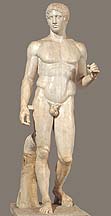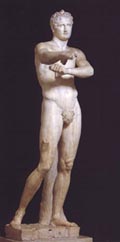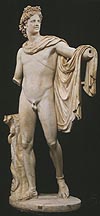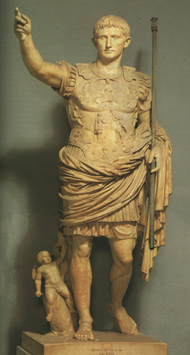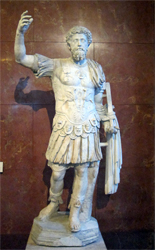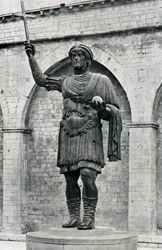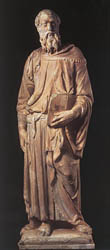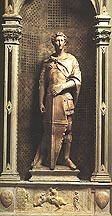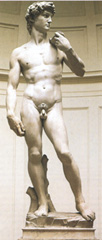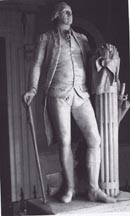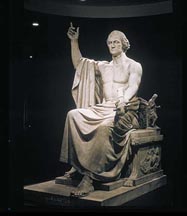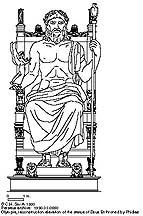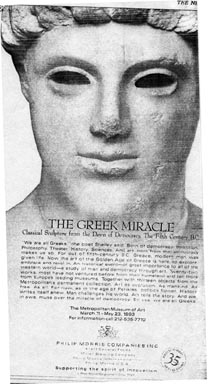Art Home| ARTH Courses| ARTH 200 Assignments
Man the Measure of Things- Protagoras of Abdera ( c. 480-410 B.C.)
Polykleitos, Doryphoros
Beginning with figures like the Kritios Boy from about 480 BCE and the Doryphoros by Polykleitos from about 440 BCE, the contrapposto pose becomes the canonical pose of the male figure in Greek art and then in western art in general. A lineage can be drawn from these Greeks precedents through Roman art into the Renaissance and continuing to the contemporary world. What follows is a preliminary gallery of images that illustrate this lineage.
Lysippos, Apoxyomenos, Roman copy of a Greek original from c. 350-325 BCE
Apollo Belvedere, Roman copy of a bronze Greek original from the late 4th century BCE
The Augustus of Primaporta, 20 BCE-14 CE
This statue is probably the most famous image of the first Roman Emperor. Augustus was very conscious of his image as a way of conveying to the Roman audience his authority. This is what is known as a cuirass statue which is a reference to the military breastplate that Augustus wears. It signifies his status as imperator or the leader of the Roman military. Art historians have shown that the portrait of Augustus is dependent on the Doryphoros. In your journal speculate why would a Roman artist have been interested in basing his work on the Greek work?
A difference between the Augustus of Primaporta and the Doryphoros is the hand gesture of Augustus which reaches out to address an audience. This is known as the ad locutio gesture, traditionally associated with the orator in Roman art. It identifies the figure as as the authority. Be aware of the history of this gesture in western art, and how the gesture of the Roman emperor will morph into the gesture of the blessing Christ.
This is a cuirass statue of the Emperor Marcus Aurelius from the middle of the second century. It demonstrates the continuity of the cuirass statue and the contrapposto pose. If you want to impress me, analyze the decoration of the cuirass of Marcus Aurelius. Can you identify the source?
This work is known as the Colossus of Barletta. It represents an unidentified Roman Emperor of the early fifth century CE. In your journal, compare this statue to the two previous examples of the cuirass statue. Consider the continuities and discontinuities between these. Pay special attention to the pose of the figure, is it contrapposto or not?
We have jumped from the world of Late Antiquity to that of the Early Renaissance. The figure above was done by the major sculptor of fifteenth century Florence, Donatello. This is an image of Saint Mark. It was made between 1411-1413 and was commissioned by the linen drapers and peddlers guild for their niche on Orsanmichele. This was one of the first works to show the reintroduction of the contrapposto pose in western art since Antiquity.
This slightly later work by Donatello representing St. George was commissioned by the armorer's guild for their niche on Orsanmichele.
The most famous monument from the Renaissance showing the continuity of the contrapposto pose is Michelangelo's famous statue of the Old  Testament hero, David. The statue was made between 1501 and 1504 and when it was completed, it was placed in front of the
Testament hero, David. The statue was made between 1501 and 1504 and when it was completed, it was placed in front of the Palazzo della Signoria, or the city hall of Florence. Michelangelo in doing this monumental nude which is approximately 14 feet tall was very intentionally referencing the nude male statues of Greek antiquity. In your journal, compare this statue to the Doryphoros of Polykleitos.
Palazzo della Signoria, or the city hall of Florence. Michelangelo in doing this monumental nude which is approximately 14 feet tall was very intentionally referencing the nude male statues of Greek antiquity. In your journal, compare this statue to the Doryphoros of Polykleitos.
Jean-Antoine Houdon, George Washington, 1788-92.
The statue of George Washington above by Houdon demonstrates the continuity of the contrapposto pose into American culture. The strong influence of Neo-Classicism on our Founding Fathers explains the connections between the founding of American Democracy and seeing its relationship to the Democracy of ancient Athens. Washington rests his right arm on what is known as fasces, a bundle of wooden sticks with an axe projecting out of the center. This was a symbol of authority in ancient Rome, but has been picked up in American symbolism. Look, for example, at the back of a "Mercury" dime, or look at the symbols on the wall behind the Speakers chair in the House of Representatives.
You might say, "At least they didn't represent George Washington as a nude figure!" But then consider the following image by Horatio Greenough:
This seated figure of authority can be traced back again to Greek art. The sculptor of the Athena Parthenos, Phidias went on to create a chryselephantine statue of Zeus for the Temple of Zeus at Olympia. Although now lost, this was one of the Seven Wonders of the Ancient World . Below is a reconstruction drawing of this image:
The advertisement above appeared in the New York Times "Arts and Leisure" section in the Spring of 1993. With a detail of the head of the Kritios Boy, it announced the opening of a show at the Metropolitan Museum of Art devoted to major monuments of Greek Classical Sculpture. As the text accompanying the ad makes explicit, a major theme of the show was the continuity of the Classical world to our world. Read the text of the ad, and in your journal comment on the major themes of the show.
I can't resist adding this image to our collection.
